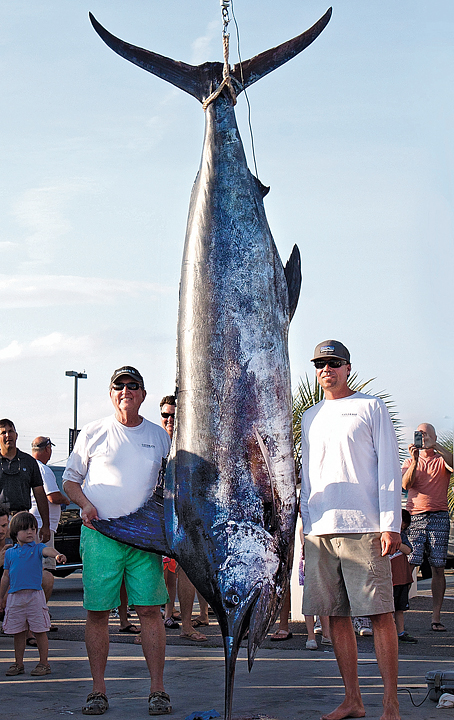For the 42nd year, anglers will venture 60 or 70 miles off the coast of Wrightsville Beach, drop their fishing lines into the deep water and hope to feel the powerful, steady tug and see the accompanying flash of blue scales and massive, streamlined body that means they’ve hooked a marlin.
The 25 or 30 crews participating in the Cape Fear Blue Marlin Tournament May 28-30 will head out to sea with renewed optimism after the multiple marlins caught during the 2014 event, including a 821-pound monster tournament organizers called the largest fish ever hooked and brought to a Wrightsville Beach dock.
The local event is one of eight billfish tournaments held off North Carolina’s coastline as a part of the North Carolina Governor’s Cup Billfishing Conservation Series. Because the competition emphasizes the importance of preserving marine ecosystems, anglers must photograph and release any marlins under 400 pounds.
Larger fish killed in the tournament will be donated to the North Carolina Division of Marine Fisheries for research and testing, event organizer John Riggs said.
The captains fish two out of three days of the event period. Ben Smith, a longtime tournament participant, said weather sometimes dictates which days to fish, but with ideal conditions forecast for the entire event, other factors will come into play.
“We’ll fish Thursday and see how the fishing is,” he said. “If the fishing was great … we’ll go right back to where we were … and if it was slow … we’ll probably wait a day for some new water to move up the coast.”
Smith said he and his crew also look at satellite images showing ocean currents, which help indicate where the most fish might be.
“The Gulf Stream comes up…like a river through the ocean, but sometimes it will have a little spinoff of water, they’re called eddies,” he said. “They’ll be spinning around and they’ll hold a lot of baitfish, and the big predator fish, like marlins … they want to be where the bait is.”
Smith said that sort of sophisticated technology has changed the sport a bit over the 40 years he’s been participating in the tournament.
“I’m still kind of an old-school guy,” he said. “I really enjoyed the days when we didn’t have all that stuff because it was more hardcore. You really had to rely on your wits and your gut feeling … because all we really had was a compass back then.”
But the essence of the sport — the anticipation of dropping a line in, the thrill of hooking a giant creature and the physical and mental struggle of reeling it in — remains, he said.
Since marlins feed near the water’s surface, he said, he usually sees the fish as it approaches and grabs the bait. The fishing line starts flying off the specialized reel as the powerful fish leaps and pulls through the water, and the struggle between man and fish begins. One time, Smith said, it took him three and one-half hours to pull in a marlin, and by tournament rules, the angler can’t pass the pole to his crewmates for relief.
“You’ve got to be in shape physically, but mental toughness, too,” he said. “You’re sitting there … an hour or two hours … connected to that fish, and you’ve got to keep your wits about you because things can happen quick.”
During one memorable tournament, Smith said he and his crew caught eight marlin. Despite that, he said he’s still lured by the possibility of catching the 1,000-pound behemoth he knows is out there. But while boating that elusive fish would be thrilling, he said it’s the hours in between catches spent with his crewmates he enjoys most.
“There’s a special bond when you’re on a boat,” he said. “It’s a small place, so you can’t get very far from each other.”
email [email protected]




